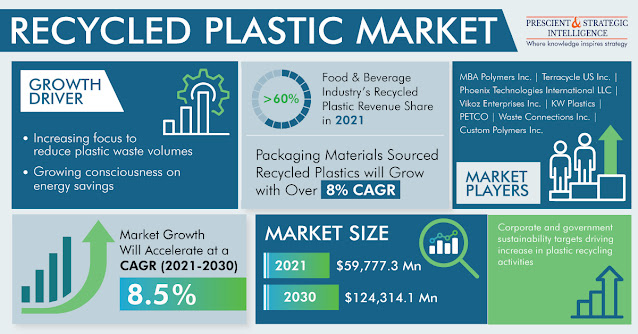To contain air, land, and marine pollution, manufacturers, governments, and customers are changing their patterns of plastic consumption, recycling, remaking goods that are easily processable post-use, and overhauling the traditional lines of production, to generate a low volume of plastic waste. All this has been a result of the increasing awareness regarding the harmful impact of plastics worldwide. Due to these reasons, the recycled plastics market is set to advance at a CAGR of 8.5% between 2021 and 2030. At this rate, the market will swell from $59,777.3 million in 2021 to $124,314.1 million by 2030.
It is the fast-paced industrialization and commercialization that have led to an increase in the consumption of plastic products. Because of this rise in consumption, a high volume of plastic waste has been generated in recent past. As per National Geographic, since the 1950s, 9.2 billion tons of plastic has been generated, of which 6.9 billion tons are now waste. The problem is that of this, merely 1.6 billion tons has been sent for recycling, with an even smaller volume actually being recycled. To deal with the issue, governments across the world have imposed certain regulations on the use of plastic.
According to P&S Intelligence, the Asia-Pacific region accounted for the highest volume of plastic recycled, due to the large-scale import and availability of domestic waste. As per data by the Organisation for Economic Corporation and Development, around 70% of plastic waste imported by APAC nations in 2016 was from high-income countries. In addition to this, cheap labor allows for smooth labor-intensive operations such as sorting, collection, and cleaning in APAC nations. Both these reasons assist in the development of small- and large-scale reprocessing facilities in India, Indonesia, China, Malaysia, Thailand, and Vietnam.
As a result, the European recycled plastic market is expected to showcase rapid growth in the future. This can also be ascribed to the several steps taken by the government to increase local production, development of domestic recycling facilities, and targets of environmental sustainability that aspire to recycle plastic products across the supply chain. European countries are expanding the capacities of their recycling units to deal with the growing plastic waste in the region.
Thus, a decline in the consumption of virgin plastic and increase in the number of recycling and reprocessing units are expected to drive recycling activities in the foreseeable future.









No comments:
Post a Comment